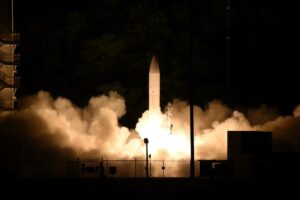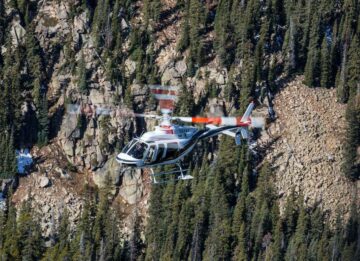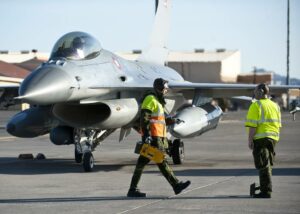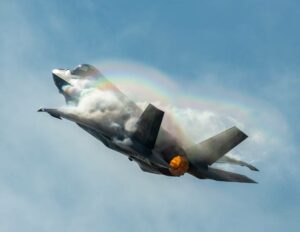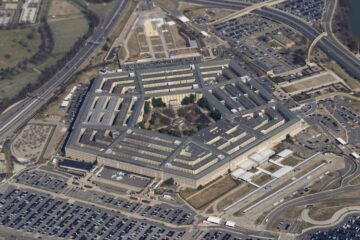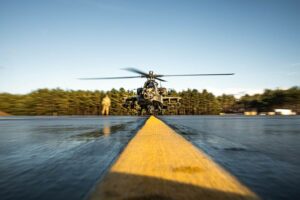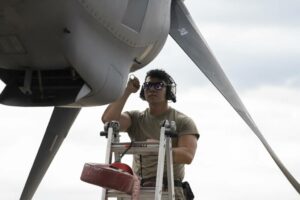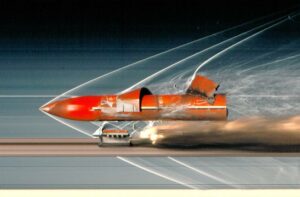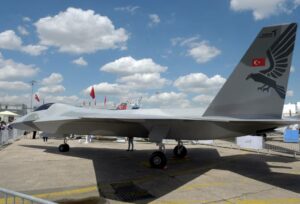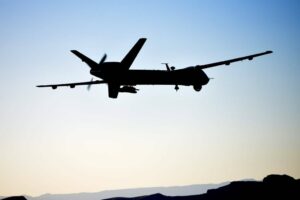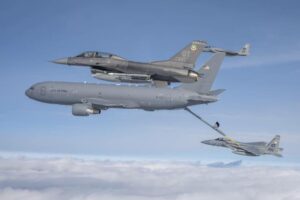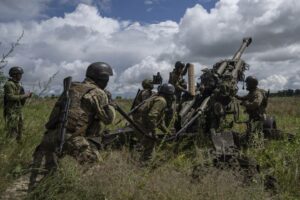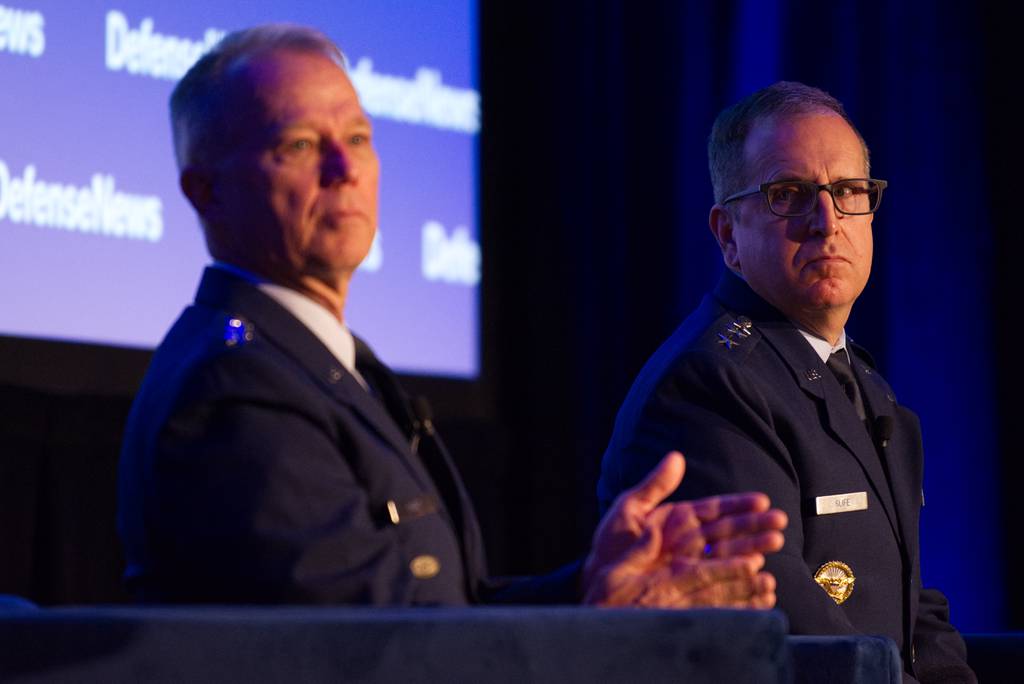
WASHINGTON — The U.S. Air Force should consider additional uses for its planned fleet of drone wingmen beyond just flying them alongside fighter jets, a top officer said Wednesday.
Lt. Gen. Jim Slife, the service’s deputy chief of staff for operations, made his pitch Wednesday at the Defense News Conference in Arlington, Virginia, suggesting the proposed collaborative combat aircraft could fly alongside the Air Force’s next-generation aerial refueling system. The service hopes to field the planned NGAS tanker by the mid-2030s, said Slife, who the White House on Wednesday nominated to be the Air Force’s next vice chief of staff.
In addition, Slife said, the Air Force could consider what role a CCA might play with the B-21 Raider stealth bomber now being built by Northrop Grumman. Air Force Secretary Frank Kendall last year floated the idea of the B-21 Raider having its own cadre of CCAs, but later dropped that plan after the service concluded it would be prohibitively expensive.
“We shouldn’t foreclose any of those things,” Slife said. “We should keep our options open for how we employ them.”
The Air Force wants to field a variety of collaborative combat aircraft later this decade able to carry out multiple missions, including strike, intelligence, surveillance, reconnaissance and electronic warfare. Air Force officials have also said CCAs could range in cost and complexity, with some expensive and exquisite, while others less costly that the service could afford to lose in combat.
As the Air Force develops CCAs with multiple vendors, it is considering how to fold them into its current squadron structures. Those decisions will also shape how the Air Force uses CCAs in a future conflict, Slife said, warning against locking the technology into organizations that could ultimately hamper potential uses.
“How we organize them will ultimately affect how we think about their utility and what can be done with them at the end of the day,” Slife said. “Might [CCAs] be able to do resupply in a contested area? It probably will. But if you make CCAs organic to our current fighter squadrons, you’re probably not going to be thinking about how we use them for resupply. If you make them organic to a C-17 squadron, we’re probably not going to think about how they can be used for [combat missions].”
“How we think about the organization of CCAs and whether we want to specialize them for certain types of missions depending on their attributes or not — I think it’s really the place that’s ripe for experimentation,” Slife added. “Those will be some of the interesting questions in the years ahead.”
The best ideas for using CCAs probably won’t come from generals, Slife said, but rather captains in the field once they receive the drones.
“As we get an initial tranche of capabilities and we’re able to put in the hands of some crews that are closely associated with the tactical missions, I think they will come up [with] ways to employ them that we haven’t even conceived of,” Slife said.
Slife explained the Air Force will likely use nontraditional acquisition authorities to help it work with multiple vendors on CCAs more quickly, and iterate new versions as the program progresses.
Gen. Mark Kelly, head of Air Combat Command, said during the panel that units in the field could adapt the less expensive versions of CCAs using open-systems architecture to tailor them to missions needed on a particular day.
But the more elaborate CCAs may not have such adaptability, Kelly said.
“We very likely will be into arenas where we have to choose: This day this CCA is going to be a jamming platform, and this day this CCA is going to be a strike platform,” Kelly said. “If you get to a different price point and you get to a different scenario, much like an F-35 — we don’t tell an F-35, ‘Today you’re going to jam this particular waveform, tomorrow you’re going to sense, and the third day you’re going to shoot.’ ”
The Navy and Marine Corps fly their own F-35 fighter jets, and the Navy is also working on its own CCA program. Kelly said that as the Air Force develops CCAs, it will need to ensure it builds them with waveforms that are able to communicate with fighters and other drones flown by sister services and allies.
He said Air Force officials usually talk to counterparts in other services at least weekly about their requirements for CCAs, such as range, payload and sensing capabilities, and their associated costs, in order to ensure interoperability.
Stephen Losey is the air warfare reporter for Defense News. He previously covered leadership and personnel issues at Air Force Times, and the Pentagon, special operations and air warfare at Military.com. He has traveled to the Middle East to cover U.S. Air Force operations.
- SEO Powered Content & PR Distribution. Get Amplified Today.
- PlatoData.Network Vertical Generative Ai. Empower Yourself. Access Here.
- PlatoAiStream. Web3 Intelligence. Knowledge Amplified. Access Here.
- PlatoESG. Automotive / EVs, Carbon, CleanTech, Energy, Environment, Solar, Waste Management. Access Here.
- PlatoHealth. Biotech and Clinical Trials Intelligence. Access Here.
- ChartPrime. Elevate your Trading Game with ChartPrime. Access Here.
- BlockOffsets. Modernizing Environmental Offset Ownership. Access Here.
- Source: https://www.defensenews.com/unmanned/2023/09/06/us-air-force-general-eyes-more-uses-for-drone-wingmen/
- :has
- :is
- :not
- :where
- $UP
- 10
- 70
- a
- Able
- About
- acquisition
- adapt
- added
- addition
- Additional
- affect
- After
- against
- ahead
- AIR
- Air Force
- aircraft
- alongside
- also
- an
- and
- any
- architecture
- ARE
- AREA
- AS
- associated
- At
- attributes
- Authorities
- Backbone
- BE
- being
- BEST
- Beyond
- builds
- built
- but
- by
- CAN
- capabilities
- carry
- certain
- chief
- Choose
- closely
- collaborative
- COM
- combat
- come
- communicate
- complexity
- conceived
- concept
- concluded
- conflict
- Consider
- considering
- Cost
- costly
- Costs
- could
- cover
- covered
- Current
- day
- decade
- decisions
- Defense
- Depending
- deputy
- develops
- different
- do
- done
- Dont
- drone
- Drones
- dropped
- during
- East
- Elaborate
- Electronic
- end
- ensure
- Even
- expensive
- explained
- exquisite
- Eyes
- field
- fighters
- FLEET
- flying
- For
- Force
- form
- frank
- Frank Kendall
- from
- future
- Gen
- General
- get
- going
- Hands
- Have
- having
- he
- head
- help
- here
- his
- hopes
- House
- How
- How To
- HTTPS
- i
- idea
- ideas
- if
- images
- in
- In other
- Including
- initial
- Intelligence
- interesting
- Interoperability
- into
- issues
- IT
- ITS
- Jets
- Jim
- jpg
- just
- Keep
- Kendall
- King
- Last
- Last Year
- later
- Leadership
- least
- less
- like
- likely
- lose
- made
- make
- Marine
- mark
- May..
- Middle
- Middle East
- might
- Military
- missions
- more
- much
- multiple
- Need
- needed
- New
- news
- next
- next-generation
- now
- of
- Officer
- officials
- on
- once
- open
- Operations
- Options
- or
- order
- organic
- organization
- organizations
- Other
- Others
- our
- out
- own
- panel
- particular
- pentagon
- Personnel
- Pitch
- Place
- plan
- planned
- platform
- plato
- Plato Data Intelligence
- PlatoData
- Play
- Point
- potential
- previously
- price
- probably
- Program
- proposed
- put
- Questions
- quickly
- range
- rather
- really
- receive
- Refueling
- reporter
- Requirements
- Role
- s
- Said
- scenario
- secretary
- sense
- service
- Services
- Shape
- Shoot
- should
- shown
- sister
- some
- special
- specialize
- Staff
- Stealth
- strike
- structures
- such
- surveillance
- system
- tactical
- Talk
- Technology
- tell
- that
- The
- their
- Them
- they
- things
- think
- Thinking
- Third
- this
- those
- times
- to
- tomorrow
- top
- traveled
- types
- u.s.
- U.S. Air Force
- Ultimately
- units
- us
- use
- used
- uses
- using
- usually
- utility
- VALKYRIE
- variety
- vendors
- very
- vice
- virginia
- want
- wants
- warning
- ways
- we
- Wednesday
- weekly
- What
- whether
- while
- white
- White House
- WHO
- will
- with
- Work
- working
- would
- year
- years
- you
- zephyrnet

